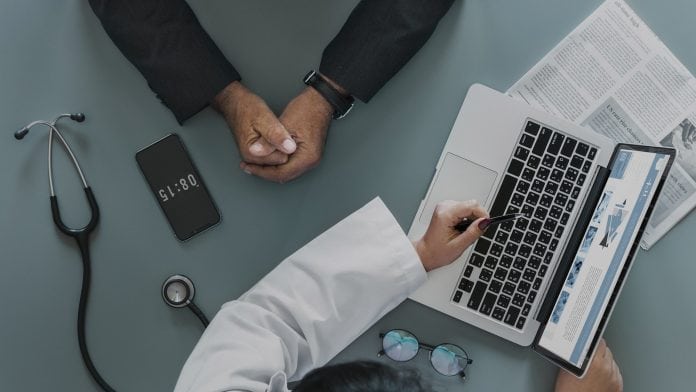
Dan Worman, the CEO of Refero, an online engagement provider to the health and social care market, argues that disruptive rather than destabilising online consultations could revolutionise the future of primary care.
In primary care, GPs are under increasing pressure as numbers decline while the population grows, along with the complexity of cases. It’s clear that change is absolutely necessary; the future of primary care must be technology enabled.
In November 2017, NHS England launched a £45m (~€51m) fund to contribute towards the costs for GP online consultation systems, as part of NHS England’s GP Forward View. This money will be split over three years, giving clinical commissioning groups (CCGs) an annual budget of £15m. Divide this number by the UK’s 58 million registered GP patients and you get a figure of 26p per patient per annum. This might not sound like much, but with the most basic services available for as low as 2p per patient per annum, this fund could revolutionise the delivery of primary care.
Appetite for disruption
We’ve already seen that there is a huge appetite for disruptive technology in GP practices. Usually involving a website or app, online consultations increasingly serve as the first point of contact between a patient and a GP, improving patient access to care and making best use of clinicians’ time.
While there has been controversy surrounding GP at Hand, the free NHS service powered by Babylon, the model has demonstrated the desire for digital-first services from both patients and forward-thinking GPs. In its first seven months, a staggering 40,000 London-based patients applied and 200 GPs signed up to the service.
Patients were drawn in by the speed with which they could book appointments (an average 38 minutes) compared to waiting a week or more in traditional practices and the potential to get a same or next day face-to-face appointment with a GP in one of five London clinics.
So far so good, but, unfortunately, there’s a flipside; by signing up to GP at Hand, patients were automatically deregistered from their GP practices. And, because Babylon set a stringent set of rules around the patients it would accept, i.e. no long-term conditions, no mental health or pregnancies, they were accused of ‘cherry picking’. When the ‘worried well’ moved over to the service, GPs were left with only the most complex and challenging cases. Because of the way funding is allocated, as registration numbers declined, this model destabilised rather than disrupted traditional models.
Leave that aside for the moment, and what GP at Hand undoubtedly demonstrates is the appetite for a revolution in the way patients want to access primary care going forward and, moreover, GPs’ willingness to embrace technology to harness new care models. So, with this mind, where do we go from here?
Bridging the gap between disruptive and traditional models
At Refero, we embrace technology that enables new ways of engaging people and connecting them with public services; we firmly believe there is a need to bridge the gap between disruptive technology and the more traditional primary care models by combining the two to deliver the best of both worlds – adding to, rather than taking away from, more established ways of working.
Ultimately, we believe it’s about arming GPs with the right tools to meet patient needs and improving access to and quality of care. It’s also about driving efficiencies in primary care and easing the growing burden on those at the coal face – the GPs.
Digital all the way…until the virtual door shuts
Today, patients are able to sign up to an online service, send requests to their GP practice such as ‘do you have my test results?’ or ‘what are your opening hours?’. These non-clinical engagements can be picked up and responded to by a receptionist or administrator. But, the real value comes from the clinical engagements, i.e. the potential for patients to enter their symptoms into an app or web-based portal which, using their demographics, presents back a list of possible ailments (taken from fully ratified and managed NHS information). Patients are then able to click on these links to find out more.
These digital services usually rely on some sort of triage system with red, orange or green flags determining next steps. For example, a green flag might signify a minor ailment and signpost the patient to a pharmacist for medication, while an orange or red flag would be directed to a practice co-ordinator to determine whether an appointment is required with a nurse or GP. It really depends upon the individual practice.
However, many online consultation services end there. Because very few platforms on the market today offer virtual appointments, the engagement reverts back to the well-trodden and offline pathway. Take eConsult, for example; it allows patients to submit their symptoms and offers self-help information, signposting to services, and a symptom checker. But, if an appointment is required, it’s back to the GP practice for a face-to-face consultation. eConsult wants to put a stop to unnecessary visits – an admirable cause but, at Refero, we believe there is a vital piece of the jigsaw missing.
We’ve seen that there is a real appetite for virtual appointments in the market. For example, we know that it’s more difficult for older people in care homes to see their GP. Across the board, patients are looking for more agile access to their GPs and many primary care providers are keen to harness the power of technology to drive efficiencies. So, why close the virtual door after initial online engagement?
One platform, multiple uses
We believe the ideal solution is one platform that enables GP practices to pick and choose from a catalogue of services that they might wish to trial or introduce: from messaging and self-help to symptoms checking and consultations (virtual or otherwise), as well as Artificial Intelligence (AI) and analytics. We like to think of these services as being like a bag of marbles – you could pick up a small one representing basic online engagement or a larger one representing virtual appointments. The key thing is bringing the many services that fall under the umbrella of online consultations together into a single platform, combined with the ability to switch elements on or off according to need.
Joining the dots between primary and secondary care
Patient-facing technology is a key part of helping ease the pressure on GP practices, but we believe it could and should go above and beyond that to help join the dots between primary and secondary care on the journey towards integrated care.
Today, it’s fair to say that the lines of communication are disjointed. But, looking forward, it is expected that these one-to-one engagements between patient and GP could become one to many, involving secondary or specialist care providers. This would enable GPs to seek advice and collaborate with healthcare providers outside of their practice. This is a real game-changer in the delivery of patient care.
To achieve this, CCGs need to take a more holistic view when it comes to procuring services. They need to avoid siloed solutions that meet one particular need and instead focus on solutions that can be rolled out regionally, within their sustainability and transformation plan (STP) footprint areas.
Dan Worman
CEO
Refero
https://refero.cloud/
This article will appear in issue 6 of Health Europa Quarterly, which will be published in August.










